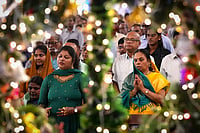
Delhi, true to its chequered past of rulers who tried to transform it into the city of their dreams, has a long history of botanical follies. "Imperial Delhi will be in the main a sea of foliage," declared Captain George Swinton, chairman of the Town Planning Committee for the new capital in 1912. Hectic activity then began, with horticulturists and forest officials having a field day picking trees from across the country and indeed, the world, to see which ones would survive Delhi's inhospitable clime. A year later, the committee had finally picked out 13 kinds of avenue trees as being just right for Delhi. The criterion: the trees should be evergreen, able to grow in Delhi and, most important, have the right shape and size to suit the design of the avenues that Sir Edward Lutyens planned.
Curiously, none of Delhi's many native trees made it to the list, not even the spectacular amaltas, whose dazzling candelabra of yellow blooms is one of Delhi's most breathtaking displays along roadsides in the height of summer. Lutyens' tree experts ruled that amaltas, like other native Delhi trees, was too untidy and shed its leaves for part of the year. Others like the banyan and kanju (Indian elm) were struck off the list for being "too overpowering". As it turned out, Delhi took its revenge on the outsiders: all the trees so carefully chosen for their evergreen foliage like jamun, neem, arjun, tamarind, sausage trees, mahua and river red gum behaved exactly like the natives: they shed their leaves in winter, not because of the cold but as a way of fighting off the long period of drought before the rains come.
Just how randomly Delhi's successive governments went about planning their foliage is clear from the fact that there are over 272 different kinds of trees standing in Delhi, enough to make a respectable botanical garden anywhere in the world. What makes this figure more remarkable, according to Krishen, is the fact that Delhi's ecology is relatively inhospitable, unlike garden cities like Bangalore. "It's like people plucked anything they fancied from anywhere in the world and planted it here, regardless of the ecological consequences."

A living monument to these tree experiments still exists, tucked away in one corner of Humayun's tomb. The government-run Sundar Nursery stretching over 90 acres was a planting field for whatever took British horticulturists' fancy. Set up by the man who was responsible for planting Delhi's avenues, Percy Lancaster, the nursery is now home to an exotic melange of trees, including a carrotwood tree from Australia and a cocaine tree from the Andes. For Krishen, who has spent years trying to identify the many exotic species that have survived straggily for nearly 50 years, these aliens are signs of the grand experiments that went into Delhi's tree planting. "These are the failures, the ones that adapted well were replanted along some road or park or even private home."
A lone Canary Island palm, for example, rises in solitary splendour in the courtyard of a colonial bungalow which is now Delhi's Women's Press Club. "Palm trees were a conceit that most bungalows adopted. And the royal palms from Cuba have become something of a cliche in parks and tombs, just as the Mughals overused the cypress to line their garden tombs," says Krishen.
The Mughals had their prejudices and fancies too. The chinar, for instance, now so emblematic of Kashmir, was introduced from Central Asia during the Mughal era. But for the most part, the Mughals relied on time-tested trees like mango, shisham, peepal and neem for their avenues. Chandni Chowk, for instance, was lined with neem and pipal trees.
But the native trees of Delhi have always had a bad deal from city planners, says Krishen. "Take a tree like the jhand, which is native to Delhi and is superbly adapted to its ecology. It's a truly magnificent tree, especially when it's in fresh leaf as it is now. But no nursery will stock it. Ask them why, and they will say there's no demand for it. And because it is not cultivated anywhere in the city, it is in danger of disappearing."
There is a worldwide movement, according to Krishen, to limit avenue trees to those that are native to the region or at least to those trees that come from similar ecological zones. And websites have come up warning of the ecological threats posed by species removed from their natural environs. "But here we have the same suite of trees planted in every city. Why can't the wide variety of our ecology be reflected in our cities?" wonders the passionate advocate of back-to-our-roots. "Why must they all look the same?" Why indeed?























